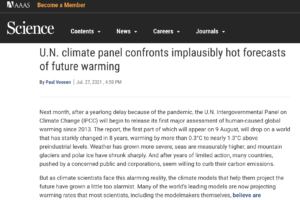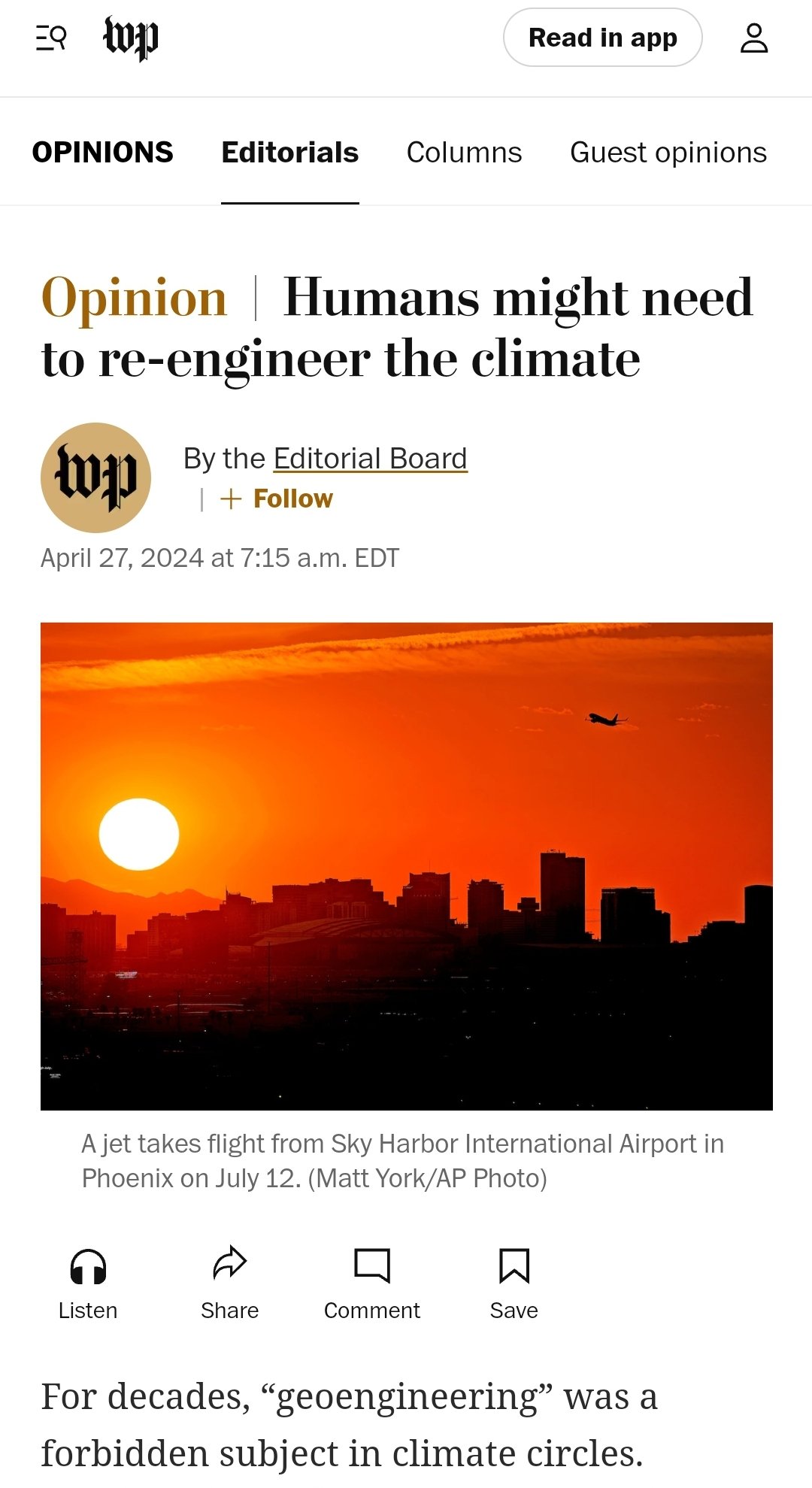Big admission from Science journal: “The climate models that project the future have grown too alarmist. Many of the world’s leading models are projecting warming rates that most scientists, including modelmakers themselves, believe are implausibly fast” https://t.co/flEskck0yd
— Michael Shellenberger (@shellenberger) July 30, 2021
U.N. climate panel confronts implausibly hot forecasts of future warming
By Paul Voosen
Next month, after a yearlong delay because of the pandemic, the U.N. Intergovernmental Panel on Climate Change (IPCC) will begin to release its first major assessment of human-caused global warming since 2013. The report, the first part of which will appear on 9 August, will drop on a world that has starkly changed in 8 years, warming by more than 0.3°C to nearly 1.3°C above preindustrial levels. Weather has grown more severe, seas are measurably higher, and mountain glaciers and polar ice have shrunk sharply. And after years of limited action, many countries, pushed by a concerned public and corporations, seem willing to curb their carbon emissions.
But as climate scientists face this alarming reality, the climate models that help them project the future have grown a little too alarmist. Many of the world’s leading models are now projecting warming rates that most scientists, including the modelmakers themselves, believe are implausibly fast. In advance of the U.N. report, scientists have scrambled to understand what went wrong and how to turn the models, which in other respects are more powerful and trustworthy than their predecessors, into useful guidance for policymakers. “It’s become clear over the last year or so that we can’t avoid this,” says Gavin Schmidt, director of NASA’s Goddard Institute for Space Studies.
Ahead of each major IPCC report, the world’s climate modeling centers run a set of scenarios for the future, calculating how different global emissions paths will alter the climate. These raw results, compiled in the Coupled Model Intercomparison Project (CMIP), then feed directly into the IPCC report. The results live on as other scientists use them to assess the impacts of climate change, insurance companies and financial institutions forecast effects on economies and infrastructure, and economists calculate the true cost of carbon emissions, says Jean-François Lamarque, a lead climate modeler at the National Center for Atmospheric Research (NCAR) and CMIP’s new director. “This is not an ivory tower type of exercise.”
In the past, most models projected a “climate sensitivity”—the warming expected when atmospheric carbon dioxide (CO2) is doubled over preindustrial times—of between 2°C and 4.5°C. Last year, a landmark paper that largely eschewed models and instead used documented factors including ongoing warming trends calculated a likely climate sensitivity of between 2.6°C and 3.9°C. But many of the new models from leading centers showed warming of more than 5°C—uncomfortably outside these bounds.
The models were also out of step with records of past climate. For example, scientists used the new model from NCAR to simulate the coldest point of the most recent ice age, 20,000 years ago. Extensive paleoclimate records suggest Earth cooled nearly 6°C compared with preindustrial times, but the model, fed with low ice age CO2 levels, had temperatures plummeting by nearly twice that much, suggesting it was far too sensitive to the ups and downs of CO2. “That is clearly outside the range of what the geological data indicate,” says Jessica Tierney, a paleoclimatologist at the University of Arizona and a co-author of the work, which appeared in Geophysical Research Letters. “It’s totally out there.”
To find out why, modelers probed the guts of the simulations, focusing on their representation of clouds, long the wild card of climate change. The models can’t simulate clouds directly, so they rely on known physics and observations to estimate cloud properties and behavior. In previous models ice crystals made up more of the low clouds in the midlatitudes of the southern Pacific Ocean and elsewhere than satellite observations seemed to justify. Ice crystals reflect less sunlight than water droplets, so as these clouds heated and the ice melted, they became more reflective and caused cooling. The new models start with more realistic clouds containing more supercooled water, which allows other dynamics driven by warming—the penetration of dry air from above and a subduing of turbulence—to thin the clouds.
But that fix has allowed scientists to spy another bias previously countered by the faulty cooling trend. In both the old and new climate models, the patchy cumulus clouds that form in the tropics thin out in response to warming, allowing in more heat than satellite observations suggest, according to a study by Timothy Myers, a cloud scientist at Lawrence Livermore National Laboratory. “Even though one feature of the climate is now more realistic, another that’s persistently biased has been revealed,” Myers says.
Overheated
By the time modelers exposed that bias, the supercomputing runs were already done and the IPCC report was nearing completion. And many of the hot models otherwise simulate the climate extremely well overall, doing a better job than their predecessors at capturing atmospheric connections between remote ocean basins and the distribution of rainfall. “You want a way you can use those models for what they have without getting stuck with their climate sensitivity,” Schmidt says.
So the IPCC team will probably use reality—the actual warming of the world over the past few decades—to constrain the CMIP projections. Several papers have shown how doing so can reduce the uncertainty of the model projections by half, and lower their most extreme projections. For 2100, in a worst-case scenario, that would reduce a raw 5°C of projected warming over preindustrial levels to 4.2°C. It’s good news for the modelers—but also a clear, and dismaying, sign that global warming has gone on long enough to help chart its own path, says Aurélien Ribes, a climate scientist at France’s National Centre for Meteorological Research. “Observations now provide a clear view for what climate change will be.”
The IPCC report is also likely to present the spatial impacts of different amounts of warming—2°C, 3°C, 4°C—rather than saying how quickly those impacts will be felt. That heat-based technique worked well in an interim IPCC report in 2018, on the impacts of 1.5°C of warming, and would preserve good information from the hot models, even if they suggest these thresholds will come too soon.
The modelers hope to do better next time around. Lamarque says they may test new simulations against recent paleoclimates, not just historical warming, while building them. He also suggests that the development process could benefit from more time, with updates every decade or so rather than the current report interval of every 7 years. And it could be helpful to divide the modeling process in two, with one track focused on scientific experimentation—when a large range of climate sensitivities is helpful—and the other on providing a best estimate to policymakers. “It’s not easy to reconcile these two approaches under a single entity,” Lamarque says.
A cadre of researchers dedicated to the task of translating the models into useful projections could also help, says Angeline Pendergrass, a climate scientist at Cornell University who helped develop one technique for weighting the model results by their accuracy and independence. “It’s an actual job to go between the basic science and the tools I’m messing around with,” she says.
For now, policymakers and other researchers need to avoid putting too much stock in the unconstrained extreme warming the latest models predict, says Claudia Tebaldi, a climate scientist at Pacific Northwest National Laboratory and one of the leaders of CMIP’s climate projections. Getting that message out will be a challenge. “These issues don’t translate very well in practice,” she says. “It’s going to be hard for people looking to make some projection of a water basin in the West to make sense of it.”
Already scientific papers are appearing using CMIP’s unconstrained worst-case scenarios for 2100, adding fire to what are already well-justified fears. But that practice needs to change, Schmidt says. “You end up with numbers for even the near-term that are insanely scary—and wrong.”
*Correction, 30 July, 9 a.m.: A previous version of this story misstated the baseline for projected warming constrained by observations; it is preindustrial, not 1986—2005.





